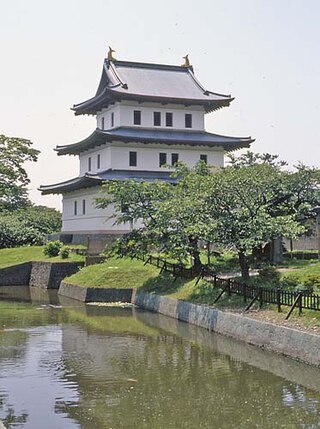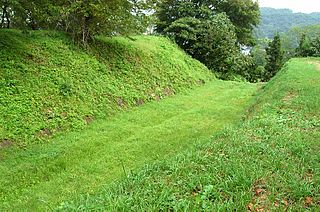Related Research Articles

Akita Prefecture [a̠kʲita̠] is a prefecture of Japan located in the Tōhoku region of Honshu. Its population is estimated 915,691 and its geographic area is 11,637 km2. Akita Prefecture is bordered by Aomori Prefecture to the north, Iwate Prefecture to the east, Miyagi Prefecture to the southeast, and Yamagata Prefecture to the south.

Yokote is a city located in Akita Prefecture, Japan. As of 23 February 2023, the city had an estimated population of 83,965 in 33949 households, and a population density of 120 persons per km². The total area of the city is 693.04 km2 (267.58 sq mi).

Nijō Castle is a flatland castle in Kyoto, Japan. The castle consists of two concentric rings (Kuruwa) of fortifications, the Ninomaru Palace, the ruins of the Honmaru Palace, various support buildings and several gardens. The surface area of the castle is 275,000 square metres, of which 8,000 square metres (86,000 sq ft) is occupied by buildings.

Matsumae Castle is a castle located in Matsumae in Hokkaidō, Japan, and is the northernmost castle in Japan. The only traditional style Edo period castle in Hokkaidō, it was the chief residence of the han (estate) of the Matsumae clan.

Senboku District is a rural district located in Akita, Japan.

Hiraka was a rural district located in southern Akita, Japan. On 1 October 2005, its remaining components- the towns of Hiraka, Jūmonji, Masuda, Omonogawa, Ōmori; and the villages of Sannai and Taiyū- merged into the city of Yokote, upon which Hiraka District was dissolved and ceased to exist as an administrative unit.

Palu is a town of Elazığ Province of Turkey. It is the seat of Palu District. The current mayor is Efrayim Ünalan (AKP). Its population is 9,602 (2021). Inhabited since ancient times, Palu was the capital of the classical Armenian region of Balabitene and then, much later, of the Kurdish Emirate of Palu. In the early 20th century, Palu was relocated from its old location to the current site.

Nihonmatsu Castle is a Japanese castle located in what is now the city of Nihonmatsu, northern Fukushima Prefecture, Japan. Throughout most of the Edo period, Nihonmatsu Castle was home to the Niwa clan, daimyō of Nihonmatsu Domain. The castle was also known as "Kasumi-ga-jō" (霞ヶ城) or "Shirahata-jō" (白旗城). The castle is one of the 100 Fine Castles of Japan, and in 2007 was designated a National Historic Site. The castle grounds are also a noted venue for viewing sakura in spring.

Hachiōji Castle was a Sengoku period Japanese castle, located in what is now the city of Hachiōji, Tokyo, in the Kantō region of Japan Its ruins have been protected as a National Historic Site since 1951, with the area under protection extended in 2005.
Senya Fault is a shallow fault system in northern Japan which was responsible for a 7.2 Rikuu earthquake in 1896, along with surface rupture. It is located near the Senya Hills in to the West of the Ou Backbone Range and east of the Yokote Basin in Akita Prefecture.

Ne Castle is a Muromachi period Motte-and-bailey-style Japanese castle located in what is now the city of Hachinohe, Aomori Prefecture, in the Tōhoku region of far northern Japan. It has been protected by the central government as a National Historic Site since 1941. It was extensively reconstructed in 1994.

Tsutsujigasaki Castle was the fortified residence of the final three generations of the Takeda clan, located in the center of the city of Kōfu, Yamanashi Prefecture, Japan. It is not a Japanese castle in the proper sense of the word, and is not referred to as a "castle" in Japanese, as it was famously the policy of the Takeda clan to "make men your castle, men your walls, men your moats". Nevertheless, it is listed as one of Japan's Top 100 Castles. The ruins have been protected as a National Historic Site since 1938. The site is open to the public and now contains the Takeda Shrine, a Shinto shrine dedicated to the deified spirits of the Takeda clan.

Nanao Castle was a Muromachi period yamajiro-style Japanese castle located in what is now the city of Nanao, Ishikawa Prefecture, in the Hokuriku region of Japan. Its ruins have been protected as a National Historic Site since 1934.

Mito Castle was a 12th-century Japanese castle with an extensive history, now in ruins, located in what was Hitachi Province. The castle ruins are located in the city of Mito, Ibaraki Prefecture, Japan.

Takaoka Castle was a flatland-style Japanese castle in what is now the city of Takaoka, Toyama Japan. It was originally constructed in 1609, and was only used for a few years before being dismantled. The site of its ruins are now a park. The castle is designated one of Japan's Top 100 Castles by the Japanese Castle Foundation. The ruins are protected as a National Historic Site.

Kunohe Castle was a Japanese castle controlled by the Nanbu clan located in what is now the city of Ninohe, Iwate Prefecture, in the Tōhoku region of far northern Japan. It was also referred to as Fukuoka Castle or Miyano Castle.

Yokote Community FM Broadcasting Co.,Ltd. is a Japanese FM station based in Yokote, Akita, Japan.

Kōkukuji Castle was a Sengoku period yamashiro-style Japanese castle located in the Negoya neighborhood of the city of Numazu, Shizuoka prefecture. The ruins have been protected as a National Historic Site since 1975.

The Ōtoriiyama ruins is an archaeological site containing a large Heian period jōsaku-style fortification located in what is now part of the city of Yokote, Akita in the Tōhoku region of Japan. The site was designated a National Historic Site of Japan in 2010.

Oyama Castle was a Japanese castle located in what is now the city of Oyama, Tochigi Prefecture, in the Kantō region of Japan. In 1991 the ruins were proclaimed a National Historic Site by the Japanese government collectively with Nakakuki Castle and Washi Castle as the "Oyama clan castle ruins". The castle is also known as Gion Castle
References
- ↑ "Yokote Castle".
- ↑ O'Grady, Daniel. "Japanese Castle Explorer - Yokote Castle - 横手城". www.japanese-castle-explorer.com.
39°19′16″N140°34′10″E / 39.32105°N 140.56931°E